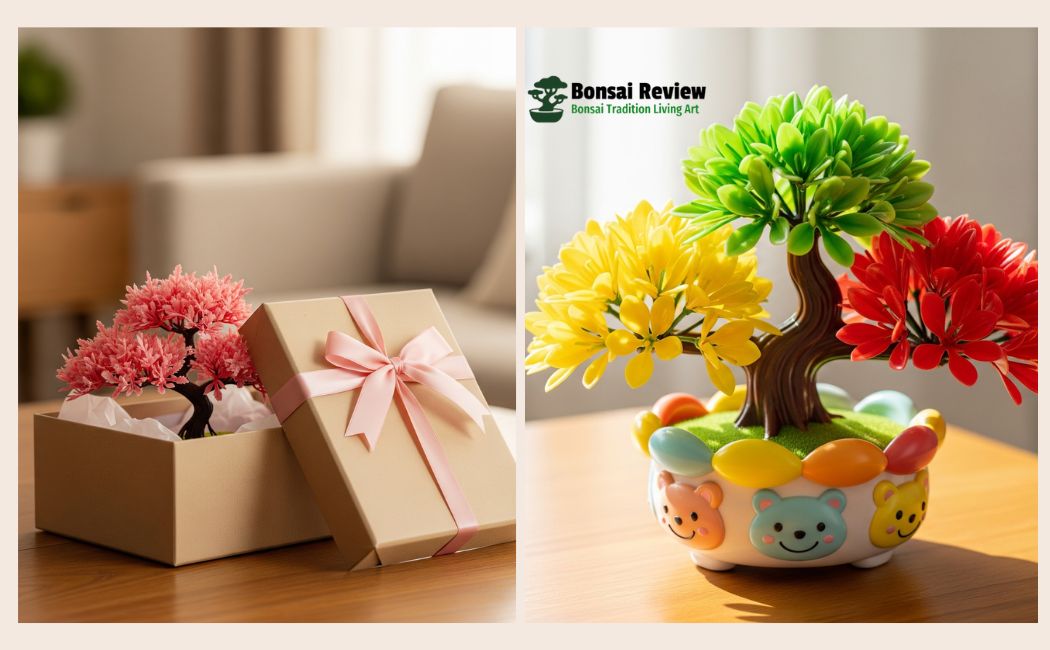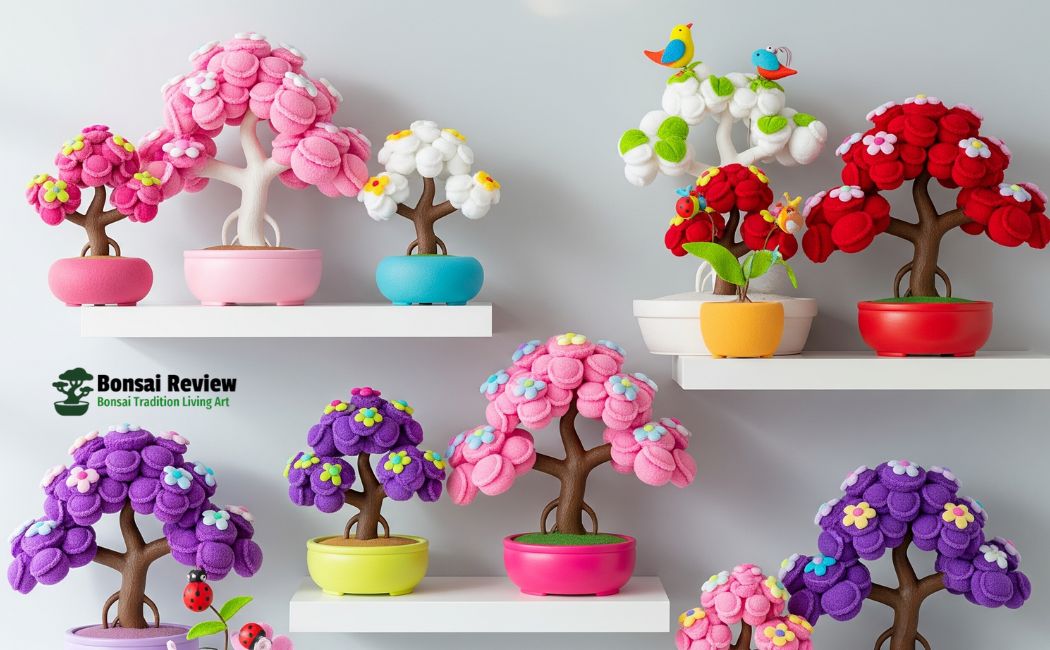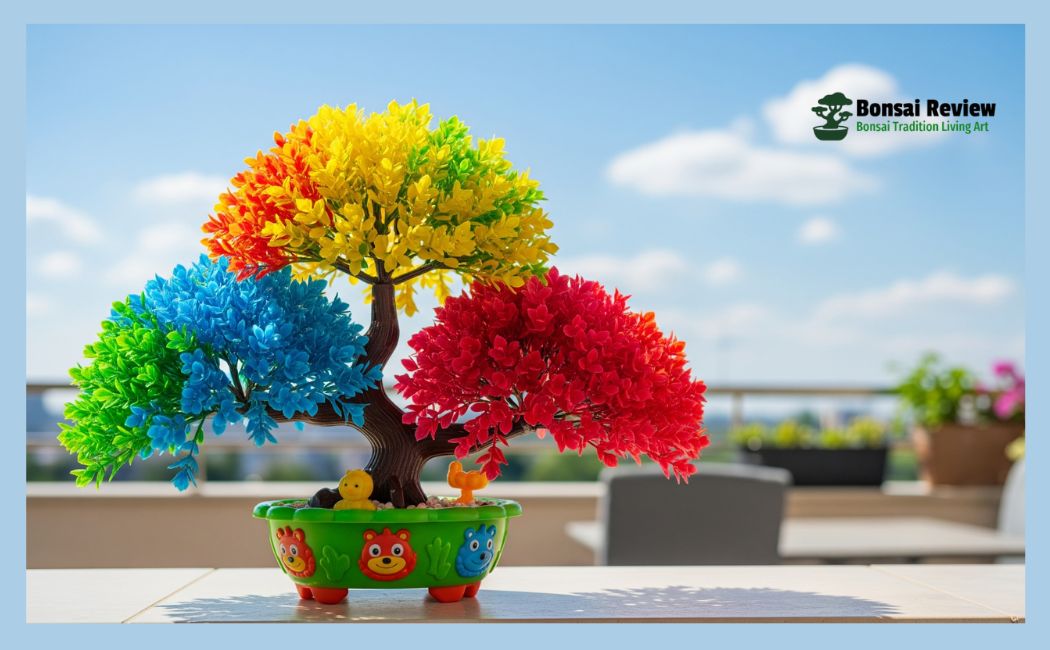The best artificial bonsai for kids! From small desk bonsai to large floor placement, colorful pink, white, purple, or red bonsai with lights.
These child-friendly trees are safe, mess-free, and perfect for gifts, classrooms, or DIY projects. You may love the beauty of a bonsai tree, but caring for one is not easy.
Real bonsai need pruning, watering, soil, and sunlight. For kids, this can be messy, fragile, and sometimes unsafe. That’s why many parents and teachers now choose an artificial bonsai for kids.
These tiny potted artificial bonsai trees bring the same charm without the risk if you need a small desk bonsai for study time.
A large floor placement bonsai for playrooms, or even a pink or green bonsai with lights, there are safe options designed for children.
With no watering, no soil, and no chance of breaking, an artificial flora bonsai becomes a simple solution.
It helps kids enjoy nature indoors, practice and learn about the history of Japanese bonsai and Chinese penjing, and still keep their space clean.
From online bonsai for sale under $70 (Approx) to colorful models like white, purple, or red bonsai trees, these safe and creative choices make nature’s magic easy for children.

Why Real Bonsai Is Hard for Kids And How Artificial Bonsai Solves It?
Many parents want their children to enjoy the calm beauty of a bonsai tree, but a real bonsai needs daily care. A living tree can dry out fast, roots can rot if overwatered, and the fragile branches can snap in a child’s hands. The soil can also make a mess indoors, which worries parents about safety and allergies.
This is where an artificial bonsai for kids becomes the perfect answer. A potted bonsai tree made from artificial flora or dried flowers and greenery keeps the look of nature without the problems. You don’t need sunlight, soil, or trimming.
A small desk bonsai can brighten up homework time, while a large floor placement bonsai adds life to a playroom. Even colorful bonsai options like pink, white, purple, or red models with lights make a child’s room playful and safe.
Parents also look at the price of bonsai trees and see that real ones can be costly to replace if damaged. In contrast, you can easily buy artificial bonsai online or find them on sale nearby, often under $70. This makes it budget-friendly for gifts, classroom décor, or even wedding decorations with artificial bonsai for kids.
However, your child enjoys the art and history of bonsai, inspired by Japanese and Chinese traditions, but with zero risk of breaking or stress about care.

Benefits of Artificial Bonsai for Kids
Artificial Bonsai for Kids: Safe, Fun, and Colorful Mini Trees for Home & School. Here’s a quick look at how different types of artificial bonsai trees for kids solve common problems:
| Problem Parents Face | Real Bonsai Drawback | Artificial Bonsai Solution | Entity Example |
| Messy soil and water spills | Soil can cause dirt, water damage furniture | No soil, no watering needed | Potted artificial bonsai for kids |
| Fragile branches | Kids can snap branches easily | Durable materials (plastic, silk, resin) | Boxwood artificial bonsai for kids |
| Safety & allergies | Mold, pollen, and insects may trigger allergies | Non-toxic, allergy-free materials | Artificial flora bonsai for kids |
| High cost of real bonsai | Living bonsai can be expensive and die easily | Affordable, long-lasting models | Artificial bonsai under $70 (Approx.) |
| Space limitation | Big bonsai needs outdoor placement | Comes in all sizes, fits any room | Small desk bonsai / Large floor bonsai |
| Children want colors | Real bonsai stays mostly green | Bright, fun options available | Pink, white, purple, red bonsai trees |
| Need for fun & learning | Real bonsai needs adult care | Kids can explore safely | Artificial bonsai with lights |
| Hard to find locally | Limited in nurseries | Easy to order anywhere | Online artificial bonsai for kids sale |

Types of Artificial Bonsai for Kids Nearby: Affordable, Safe, and Mess-Free Trees.
Not every child’s space is the same, and that’s why artificial bonsai trees come in many shapes, sizes, and colors. Here are some of the most popular options parents and teachers choose:
1. Small Desk Bonsai
Perfect for study tables and homework corners. These mini bonsai trees fit in tight spaces and bring focus without clutter.
2. Large Floor Placement Bonsai
For playrooms or living rooms, a large artificial bonsai for kids makes a bold, fun statement. Strong and steady, it won’t break easily if touched.
3. Potted Bonsai Trees
Classic style with safe, lightweight pots. A potted artificial bonsai is easy to move and looks natural indoors or outdoors.
4. Colorful Bonsai Options
Children love bright colors. Choices like pink bonsai, white bonsai, purple bonsai, or even red bonsai add playfulness.
5. Artificial Bonsai with Lights
A favorite for bedrooms. A glowing bonsai doubles as a night lamp and makes the room magical.
6. Boxwood Bonsai
A Boxwood bonsai plant in a durable style, often made with artificial flora or dried flowers & greenery, is perfect for classrooms or learning areas.
7. Outdoor Artificial Bonsai
Weather-resistant types can be placed outside on balconies or patios. They add nature’s touch without the need for care.

How to Choose the Right Artificial Bonsai for Kids?
When buying an artificial bonsai for kids, the key is to match safety, style, and budget with your child’s needs. Here’s what to check:
1. Safety First
Choose bonsai made from non-toxic materials, such as silk, eco-friendly resin, or safe plastics. This avoids worries about allergies, mold, or sharp edges.
2. Size and Placement
Think about where it will go. A small desk bonsai works best for homework areas, while a large floor bonsai is ideal for playrooms. For outdoors, look for a weather-resistant artificial bonsai.
3. Colors and Fun Designs
Kids love bright and creative looks. A pink, white, purple, or red bonsai can match their room theme. For extra fun, choose an artificial bonsai with lights that doubles as décor and a night lamp.
4. Durability
Children may play with the tree, so pick sturdy potted bonsai trees that can handle bumps without breaking. Styles like boxwood artificial bonsai or artificial flora with dried flowers are stronger choices.
5. Budget and Price
Real bonsai trees can cost a lot, but you can find artificial bonsai for kids under $70. Always compare price options online and check for bonsai on sale nearby before buying.
6. Where to Buy
You can buy artificial bonsai online from Amazon, Etsy, or home décor shops. Local garden stores also carry them, especially potted bonsai trees for sale in the kids’ décor section.

Creative Uses of Artificial Bonsai for Kids
Artificial bonsai is more than just décor. It can inspire, teach, and even add joy to special moments. Here are some creative ways kids can enjoy them:
1. Room Décor
A small desk bonsai makes homework time calm, while a floor placement bonsai brightens up play areas. Colored options like pink or green bonsai trees can match a child’s themed room.
2. School Projects
Teachers often use artificial flora bonsai to show kids how a bonsai tree looks like without the worry of watering or breaking. This makes learning about Japanese bonsai history and Chinese penjing simple and fun.
3. Gifts for Kids
An artificial bonsai under $70 (approx.) makes a thoughtful birthday or holiday gift. You can even choose a bonsai with lights for a magical surprise.
4. Classroom Décor
A potted artificial bonsai brings a calming effect to classrooms. Some schools use boxwood bonsai or artificial & dried flower bonsai for eco-friendly teaching corners.
5. Special Occasions
Families use wedding artificial bonsai for kids to decorate event spaces in a playful yet stylish way. It keeps the theme nature-friendly but safe for children to be around.
6. DIY Fun
Kids can add their touch to a DIY artificial bonsai by painting pots, adding stones, or stringing fairy lights. It’s a creative activity that connects them with nature, even indoors.

Conclusion: Safe and Fun Artificial Bonsai for Kids: History, Benefits, and Buying Guide.
A real bonsai tree is beautiful, but it takes time, care, and patience that kids may not be ready for. That’s why an artificial bonsai for kids is such a smart choice. It keeps the magic of a miniature tree alive, but without soil, water, or fragile branches.
Whether you pick a small desk bonsai, a large floor bonsai, or a potted bonsai in fun colors like pink, white, or purple, every option is safe and child-friendly.
Parents love them for their low price, teachers use them for classroom décor, and kids enjoy them as gifts, DIY crafts, or even glowing bonsai with lights.
From the long history of Japanese bonsai and Chinese penjing, to modern artificial flora bonsai for kids on sale online or nearby, these tiny trees continue to inspire.
They bring peace, creativity, and nature’s beauty into a child’s world, all with no worries about care or cost.
If you want your child to feel close to nature while staying safe and mess-free, an artificial bonsai might be the perfect start.
Helpful and informative article: How to draw a simple bonsai tree for kids?
FAQs: Creative Ways Kids Can Enjoy Artificial Bonsai: Gifts, Décor, and Learning.
1. What is bonsai for kids?
Bonsai are trees and plants grown in containers in such a way that they look their most beautiful, even prettier than those growing in the wild. Cultivating bonsai, therefore, is a very artistic hobby as well as a traditional Japanese art.
2. Is artificial bonsai safe for kids?
Yes. Most artificial bonsai for kids are made from non-toxic plastic, silk, or eco-friendly resin, which makes them safe to touch and play with. Always check labels to ensure they are child-friendly.
3. Why choose artificial bonsai instead of real bonsai for children?
Real bonsai trees need pruning, watering, and sunlight. They can break easily and create a mess with soil. An artificial bonsai gives the same beauty but is safe, durable, and maintenance-free, perfect for kids.
4. How much does an artificial bonsai for kids cost?
You can find many good options of artificial bonsai under $70. Prices vary depending on size, design, and whether you want extras like bonsai with lights or colorful styles.
5. What sizes are available for artificial bonsai?
They come in many sizes: a small desk bonsai for study tables, a potted bonsai for shelves, or a large floor placement bonsai for playrooms. Outdoor types are also available.
6. Can I buy artificial bonsai for kids online?
Yes. You can easily buy artificial bonsai online from Amazon, Etsy, or garden décor shops. Many local stores also carry them, and you can often find bonsai on sale nearby.
7. Do kids like colorful bonsai trees?
Yes. Children often enjoy playful options like pink, white, purple, or red bonsai trees. Some even come with glowing lights to use as a night lamp.
8. Can artificial bonsai be used for school or special events?
Absolutely! Teachers use them in classrooms as educational bonsai models. Families also use wedding artificial bonsai for kids or DIY bonsai crafts as creative activities.
9. What is the easiest bonsai for a beginner?
The easiest bonsai for beginners are typically ficus, jade, and Chinese elm. These trees are known for their resilience and ability to tolerate beginner mistakes like inconsistent watering. Ficus, in particular, is often recommended as the easiest indoor bonsai for beginners due to its hardiness and adaptability.
10. Is bonsai a plant or an art?
Bonsai is both a tree and an art form. It refers to the practice of cultivating miniature, ornamental trees in containers, shaping them through techniques like pruning and wiring to resemble a full-sized, mature tree. The art of bonsai involves a partnership between the artist and the tree, where the artist’s vision is realized through the tree’s natural characteristics and growth patterns.